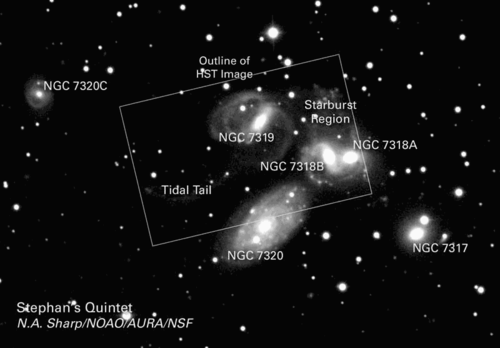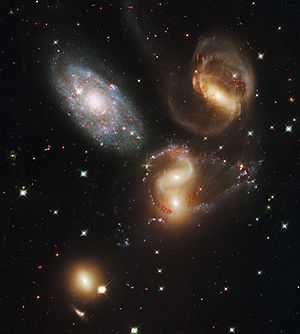Stephan's Quintet
| Stephan's Quintet | |
|---|---|
|
Credit: HST | |
| Observation data (Epoch J2000) | |
| Constellation(s) | Pegasus |
| Right ascension | 22h 35m 57.5s[1] |
| Declination | +33° 57′ 36″[1] |
| Brightest member | NGC 7318B[1] |
| Number of galaxies | 4[1] |
| Other designations | |
| HCG 92, Arp 319, VV 288,[1] SQ[2] | |
| See also: Galaxy groups, Galaxy clusters, List of galaxy clusters | |
Stephan's Quintet in the constellation Pegasus is a visual grouping of five galaxies of which four form the first compact galaxy group ever discovered.[2] The group was discovered by Édouard Stephan in 1877 at Marseille Observatory.[3] The group is the most studied of all the compact galaxy groups.[2] The brightest member of the visual grouping is NGC 7320 that is shown to have extensive H II regions, identified as red blobs, where active star formation is occurring.
Description
These galaxies are of interest because of their violent collisions. Four of the five galaxies in Stephan's Quintet form a physical association, Hickson Compact Group 92, and are involved in a cosmic dance that most likely will end with the galaxies merging. Radio observations in the early 1970s revealed a mysterious filament of emission which lies in inter-galactic space between the galaxies in the group. This same region is also detected in the faint glow of ionized atomic hydrogen seen in the visible part of the spectrum as the magnificent green arc in the picture to the right. Two space telescopes have recently provided new insight into the nature of the strange filament, which is now believed to be a giant intergalactic shock-wave (similar to a sonic boom but traveling in intergalactic gas rather than air) caused by one galaxy (NGC 7318B) falling into the center of the group at several millions of miles per hour.
X-ray source

As NGC 7318B collides with gas in the group, a huge shock wave bigger than the Milky Way spreads throughout the medium between the galaxies, heating some of the gas to temperatures of millions of degrees where they emit X-rays detectable with the NASA Chandra X-ray Observatory.
Molecular hydrogen emission
Perhaps even more unexpected is the discovery of very powerful molecular hydrogen signals from the shock wave, seen by the NASA Spitzer Space Telescope which detects infrared radiation. The molecular hydrogen emission, which is seen through infrared spectral analysis using the Spitzer Space Telescope is one of the most turbulent formations of molecular hydrogen ever seen, and the strongest emission originates near the center of the green area in the visible light picture discussed earlier. This phenomenon was discovered by an international team led by scientists at the California Institute of Technology and includes scientists from Australia, Germany and China. The detection of molecular hydrogen from the collision was initially unexpected because the hydrogen molecule is very fragile and is easily destroyed in shock waves of the kind expected in Stephan's Quintet. However, one solution is that when a shock front moves through a cloudy medium like the center of the group, millions of smaller shocks are produced in a turbulent layer, and this can allow molecular hydrogen to survive. Most notable is the fact that this collision can help provide a view into what happened in the postulated beginning of the universe some 14 billion years ago, since shocked molecular hydrogen is likely to be present in the early universe.
Redshift
Also of interest, NGC 7320 (to the lower left in both photos) indicates a small redshift (790 km/s) while the other four exhibit large redshifts (near 6600 km/s). Since galactic redshift is proportional to distance, NGC 7320 is only a foreground projection[2] and is ~39 million ly[2] from Earth versus the 210-340 million ly of the other five.
NGC 7319 has a type 2 Seyfert nucleus.
Members

The five visually adjacent galaxies of Stephan's Quintet are NGC 7317–7320. NGC 7320, however, is a foreground object roughly 40 million ly away, significantly closer than the others at about 290 million ly, and not part of the Hickson association. The visual distinction between 7320 and the others in the 2009 HST image below is quite striking. A sixth galaxy, NGC 7320C, probably belongs to the association: it has a redshift similar to the Hickson galaxies, and a tidal tail appears to connect it with NGC 7319.
| Name | Type[4] | R.A. (J2000)[4] | Dec. (J2000)[4] | Redshift (km/s)[4] | Apparent Magnitude[4] |
|---|---|---|---|---|---|
| NGC 7317 | E4 | 22h 35m 51.9s | +33° 56′ 42″ | 6599 ± 26 | +14.6 |
| NGC 7318a (UGC 12099) |
E2 pec | 22h 35m 56.7s | +33° 57′ 56″ | 6630 ± 23 | +14.3 |
| NGC 7318b (UGC 12100) |
SB(s)bc pec | 22h 35m 58.4s | +33° 57′ 57″ | 5774 ± 24 | +13.9 |
| NGC 7319 | SB(s)bc pec | 22h 36m 03.5s | +33° 58′ 33″ | 6747 ± 7 | +14.1 |
| NGC 7320c | (R)SAB(s)0/a | 22h 36m 20.4s | +33° 59′ 06″ | 5985 ± 9 | +16.7 |
Other images
-

Stephan's Quintet region, 32 inch Schulman Foundation telescope on Mt. Lemmon, AZ.
See also
Notes
- ↑ 1.0 1.1 1.2 1.3 1.4 "NASA/IPAC Extragalactic Database". Results for HCG 92. Retrieved 2006-09-18.
- ↑ 2.0 2.1 2.2 2.3 2.4 Moles, M.; Marquez, I.; Sulentic, J. W. (1998). "The observational status of Stephan's Quintet". Astronomy and Astrophysics 334: 473–481. arXiv:astro-ph/9802328. Bibcode:1998A&A...334..473M.
- ↑ Stephan, M. E. (1877). "Nebulæ (new) discovered and observed at the observatory of Marseille, 1876 and 1877, M. Stephan". Monthly Notices of the Royal Astronomical Society 37: 334–339. Bibcode:1877MNRAS..37..334S.
- ↑ 4.0 4.1 4.2 4.3 4.4 "NASA/IPAC Extragalactic Database". Results for various galaxies. Retrieved 2006-10-20.
References
- A Shocking Surprise in Stephan's Quintet. 2 March 2006. 10 March 2006 NASA/JPL-Caltech/Max-Planck Institute/P. Appleton article
- P.N. Appleton, K.C. Xu, W. Reach, M.A. Dopita, Y. Gao, N. Lu, C.C. Popescu, J.W. Sulentic, R.J. Tuffs, and M.S. Yun. Powerful High-Velocity Dispersion Molecular Hydrogen Associated with an Intergalactic Shock Wave in Stephan's Quintet, The Astrophysical Journal, 639:L51-L54, 3 March 2006. 10 March 2006 Gigantic cosmic cataclysm in Stephan's Quintet of galaxies
- Stephan's Quintet. 10 March 2006 University of Alabama Astronomy
- Stephan's Quintet: Intruder Galaxy Shocks Tightly-Knit Group. 8 May 03. 10 March 2006 Chandra X-Ray Observatory
- Stephan's Quintet, photo and description from the National Optical Astronomy Observatory. Links to a labeled locator photo.
External links
| Wikimedia Commons has media related to Stephan's Quintet. |
- GALEX: Stephan's Quintet and NGC 7331
- Star Clusters Born in the Wreckage of Cosmic Collisions
- News Release at ESA/Hubble
- Stephan's Quintet
- NightSkyInfo.com : Stephan's Quintet
- What's Behind Stephan's Quintet? Peter Edmonds, Chandra Blog, 21 July 2009
- Astronomy Picture of the Day on Stephan's Quintet: 13 Nov 2000 12 Aug 2003 11 Sep 2009
- Stephan's Quintet on WikiSky: DSS2, SDSS, GALEX, IRAS, Hydrogen α, X-Ray, Astrophoto, Sky Map, Articles and images

